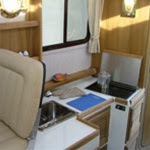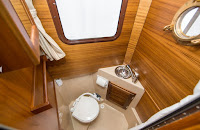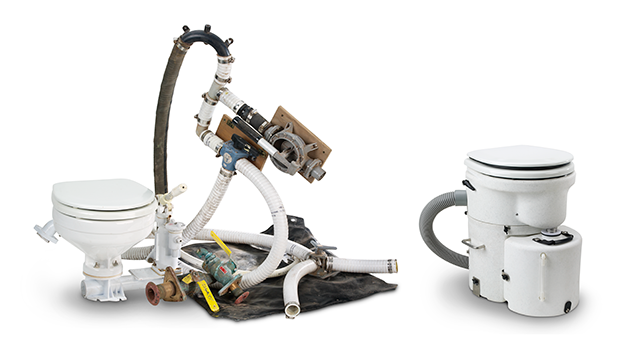We (my wife and I) arrived Saturday after dark at the Sanford Boat Works & Marina at the extreme southern end of the navigable portion of the 300+ mile long St. Johns River. I couldn't get the lights on in the boat even though the panel showed the 120 volt power was working. The lady, Debbie, in the next door houseboat brought us a flashlight and she and her husband, Tom, offered hints and ideas. Finally, she said her brother had a tug boat on the Chesapeake and she'd call him for help... Needless to say I ignored all this while moving about the boat with the flashlight trying to figure out the problem. The Chesapeake fellow suggested that I should turn on the battery switch-–duh! I do the same thing (forget the battery switch) in our camper every year. Anyway we had lights, and two new friends, Debbie & Tom. I referred to Debbie, as my hero after that experience!
Still, after the lights came on we found the boat full of the boxes of tools and stuff I had UPSed down in advance of our arrival, along with the huge bimini stainless U-shaped frame neatly tied up INSIDE the boat, instead of folded up outside attached to the rear cockpit where it belongs. I guess the Mobile, AL canvas installer did not want it damaged in transit, but now we had to lug it out it the dark and tie it down outside the boat. Boy were we beat–we collapsed in the V-berth and passed out from a long day.
ASIDE: I bought the canvas bimini and SS frame from King Marine in Washington state as they make the factory mounted biminis. The cost was 45% of having a local canvas maker do it all as King has the templates and can knock out the bimini quickly. Dave, King's owner, was great and accessible by cell phone and I had it professionally mounted in Mobile, AL as I was loath to drill holes in the boat. It all came together nicely, was well made and fitted great. For those of you with Rangers I'll post details and pictures of the frame on the TugNuts site in Alto's photo album eventually.
Still, after the lights came on we found the boat full of the boxes of tools and stuff I had UPSed down in advance of our arrival, along with the huge bimini stainless U-shaped frame neatly tied up INSIDE the boat, instead of folded up outside attached to the rear cockpit where it belongs. I guess the Mobile, AL canvas installer did not want it damaged in transit, but now we had to lug it out it the dark and tie it down outside the boat. Boy were we beat–we collapsed in the V-berth and passed out from a long day.
ASIDE: I bought the canvas bimini and SS frame from King Marine in Washington state as they make the factory mounted biminis. The cost was 45% of having a local canvas maker do it all as King has the templates and can knock out the bimini quickly. Dave, King's owner, was great and accessible by cell phone and I had it professionally mounted in Mobile, AL as I was loath to drill holes in the boat. It all came together nicely, was well made and fitted great. For those of you with Rangers I'll post details and pictures of the frame on the TugNuts site in Alto's photo album eventually.
Here's Alto in her covered slip in her floating dock on Sunday:
Here she is from the rear. A very cool thing is that the covering roof is attached to the docks, not the river bottom. A couple years ago the river rose 6+ feet and would have crushed boats in berths under a roof attached to pilings driven into the river bed. Also, since the roof always stays at the same height in relation to the dock, I don't have to lower the mast for fear of a rise in water pushing the boat up under the roof.
Note the Ranger Tug slight list to the left. This is almost a trademark and is probably is due to the diesel generator and four batteries stowed on the left side of the cockpit. I'll try to even out the boat with storage solutions, but others have tried before... Below, from the cockpit looking aft you can see where we park our compact rental car next to the little bath house with a green roof. I can see if its occupied from the boat, thus saving energy from a wasted walk! The oval-like part in the rear plastic window allows me to zip the plastic and roll it up (holding it with the two hanging straps) to expose the screen.
We got friendly with the folks, Tom and Debbie (my hero), in the houseboat at the end of the dock shown below. They live in Tampa and pay around $500/month to moor the houseboat where you see it. They also own the pontoon boat between their house boat and Alto–it has a fold-up bathroom! They have incredible views, especially from the roof (where there is a hot tub) down the river. One wall of the houseboat is glass, looking out at the marina. Not bad for $500/month.
They warned us of some little issues around the marina like the fact that occasionally an alligator will haul itself up on the floating docks, so we need to look before stepping off the boat each and every time. Also we borrowed bug spray from them, at their strong recommendation, to spray the boat's perimeter as roaches (nicely called Palmetto Bugs in Fl) and other bugs get into the boats. We learned about the wolf spider which grows to the size of your hand... Blind Flies (a type of midge) can suddenly assault any object or structure on the St. Johns. "Assault" isn't the right word, as they can swarm and die in an hour to the point where people use snow shovels to remove 6 inch+ piles of them from boats. Then there are the routine mosquitoes and midges to deal with... Gail was thrilled with all this, of course. She reports over 40 itchy insect bites on her ankles upon our return home.
Here's a shot of the boat from the bathroom's (which I had just visited) door. You can see Tom and Deb's houseboat to the right:
Here's a view off our starboard side. You can see fixed docks with stationary (attached to the river bottom) roofs to the right. You can just make out a white building under the State Highway 415 overpass in the middle of the picture at the back which is Gators bar right on the main river. Its a giant deck covered with an awning and plastic windows that serves fresh seafood. We could walk to it in a minute or two, but we drive to save our energy, of course. Gators has live music a couple nights weekly, but only until 10 PM. Bikers come on Sunday when they have music until 6 PM, not too many Hell's Angels show up. Its generally pretty quiet in the marina.
The first two days (Sunday and Monday) we spent doing trips to Walmart and West Marine getting "stuff." We had eight boxes of more "stuff" that I had pre-shipped via UPS to the marina folks who then stacked the boxes up inside the boat to wait for us. We had to set up the bimini (canvas cover and stainless steel tubing that holds it up) too. Gail stowed stuff in various places and then tried alterations. We had to get a foam mattress topper from Walmart and cut it in the shape of a V (which I did on the houseboat's deck) since the V-berth mattress was too hard to sleep well on. We were exhausted, but did get into the old part of Sanford for a dinner at a restaurant called Two Blondes and a Shrimp; don't even ask about how it got its name. The food was excellent and we heard the chef's story of how her restaurant in the Keys washed away in a hurricane, so she became a New Jersey cop for five years, before teaching culinary arts, etc. Since I first wrote this blog, Sanford became famous for the Zimmerman/Trayvon murder episode. This blots out all the effort and expense Sanford has engaged in to make the downtown attractive to visitors. They spend a fortune on the "River Walk" which includes a town marina all on Lake Munroe just north of our marina. We enjoyed our time in Sanford, and my wife is "of color" as they say so I would encourage any and all to visit this neat little city. Deland just to the north on the river is where Hontoon is and is also a great college town. It's home to Stetson University, larged funded by the guy who invented the Stetson hat.
Here's the view from Alto's port side showing the dock access which we walk down to get to shore (the car and bathroom):
Directly in front of the Alto is a mint, restored 1988 Sea Ray with our new friends (Chuck and Evelyn) who just retired. They live in Daytona, but often come to hang on their boat and fish. In fact, they caught fish off the dock between our boats, fried it up and we all ate it along with the our friends on the houseboat, named $tock Option$', folks (Tom and Debbie) on the dock. Evelyn, or Ev, gets cold ears so she wears ear muffs, which is a little weird in Florida, especially as we heard it was 20 degrees in Mass. at the time I took this picture. Ev is getting ready to feed their dog, Bear who growls at me and Debbie whenever we walk by. Tom and Debbie have three tiny dogs that stay on the houseboat. The dock is sort of like a living room in the evening with tables and chairs...and midges around your ankles.
The weather had been cool with little rain showers, but Wednesday was beautiful. T-shirt weather and clear skies with no wind (bad for sailing but good for power boating). Chuck pushed us off and we motored into the channel towards Lake Monroe:
Soon after we entered Lake Monroe where we got the boat up to 15 knots for a spell and passed the town of Sanford which sits on the lake's western shore. It has an "old" section in the center with brick streets and nice restaurants like the Two Blondes and a Shrimp, mentioned before.
We entered the lake's outflow channel which is the St. Johns River and had to wait for a railroad bridge to open. We then followed the meandering river for about 15 miles North to the Hontoon State Park. By meandering I mean it could turn to the point where we would be heading South again for periods of time. We saw many manatee swimming by–actually, we saw their wake or bubbles as they pass like ghosts under the boat. Alligators hang out on the shores or swim by, and there are amazing birds. The shores are covered by trees with spanish moss hanging down with foot-in-diameter balls of mistletoe which mysteriously grow without roots in the tops of the trees. Local folks shoot the mistletoe out of the trees with shot guns to sell around Christmas.
Our plan was to meet up with Frank & Cathy Forest who live in DeLand, FL which is a historic small city in "old Florida" and the home of Stetson University, which was founded with a donation from the Stetson hat maker. Frank has a sistership tugboat to the Alto. We had been in communication via the TugNuts chat/blog website for months when I decided to debut the boat on the St Johns and I found out he was already on the river. He is a serious Ranger Tug Nut who knows much about the boats and the river and I was anxious to meet him and his wife. I called him and he came "up" the river (heading south) while we went north and we met up. I then followed him to the Hontoon Island area, here's us following him down river (remember the St. Johns flows north):
We decided to stay in his marina in a transient slip instead of in the state park marina which was about 500 feet away on the island to the left in this picture; in fact, you can see Hontoon Island a few hundred feet behind the boats in the picture, below. We had electricity, water and access to the Hontoon Marina Resort (which had nice bathrooms) for $25 per night and the transient dock was adjacent to Frank's boat, as you see to the right of Alto below–sorry about the sun spot which is, luckily, on Ainokea rather than on Alto:
You can see we both have Phifertex front window covers which come in several colors which cut out about 90% of the sun from entering the boat. Its a very heavy weave fabric. They also function as privacy screens at night when on the dock although they work in reverse, too. So if you have a light on inside the boat and its dark outside, then people can see in but you can't see out.
Detail oriented tug boat owners can see the forward folding mast (with radar on it) on Alto vs. the side-folding mast on Ainokea in the following picture. Ainokea is Hawaiian for "I don't care" or "I do what I want." Perfect!
Detail oriented tug boat owners can see the forward folding mast (with radar on it) on Alto vs. the side-folding mast on Ainokea in the following picture. Ainokea is Hawaiian for "I don't care" or "I do what I want." Perfect!
Frank has attached a very cool barbecue on a removable post on his aft swim platform. I had admired this addition on the TugNuts website where Frank has some pictures of the modifications he and Cathy have done to Ainokea. I had bought a grill and post and had it shipped to Alto's marina and copied Frank and did the same installation (except I used a small round Magma grill) on Alto before we left Florida. Frank made hamburgers and he, Cathy, Gail and I all had dinner in his boat, very comfortably and enjoyably, that night.
We really enjoyed the trip up to Hontoon and hanging out with Frank and Cathy. Frank gave us a guided tour over the radio as we followed him up the river, often at idle speed (ludicrously slow speed) in the Manatee zones. Here's a better picture of Frank.
The next day, Thursday, was as beautiful and perfect as the previous day. We set out back up river heading south towards Sanford. The trip took about 3.5 hours and we got home to our marina around 4. Had dinner at Gators and crashed. Friday was rainy so we spent it doing laundry at the yacht club (we had to join the club to get access to the washer and dryer) for $30/month. I need to get a burgee as we are now official members of the Indian Mound Yacht Club; I'm going to see if I can get reciprocal mooring privileges at slightly more fancy clubs in Edgartown, Hyannisport, and at the New York Yacht Club. Gail found a leak under the bathroom sink which I fixed with a great deal of contortion to get into the small spaces. We spent the day fixing minor problems like mis-wiring of the stereo.
Organizing the boat took well into the night so we ate crackers and any remaining food on the boat and went to bed. Up at six the next day, Saturday, to head to the airport in Orlando and back to Logan. Gail's Jeep had a dead battery and the nice folks at Thrifty Parking tried their best to clean the terminals and fix it, but it wouldn't hold much of a charge. I feared it would die when we slowed down to pay the toll to go through the Williams Tunnel so we had AAA come and replace the battery while we were waiting in the warm Thrifty office. Then a stop for dinner at Bertucci's in Hingham and home to see the cats!
 |
| Cody |
 |
| Tiger |
 |
| Panda |
And, all our friends and family. Stay tuned as the next trip in Alto is scheduled for February 15th. We'll deal with suspect overheating, hopefully new voyage pictures, and (if you are lucky) lots of shots of our specially installed COMPOSTING TOILET, about which I'm very excited, I really must say!
The detachable urine container (euphemistically called "fluid" vs. the "solids" container) needs to emptied every 3 days, so we may have some shots of me walking the dock with the "pee bucket" as we choose to call it. However, I'll never have to pump out a 30 gallon waste tank of you-know-what sloshing around in the back of the boat. We empty the solids container once (that's ONCE) a yearly season, which yields a few coffee can sized hunks of compost which can be put on a garden or spread on the lawn without any smell. More about all this later!












































